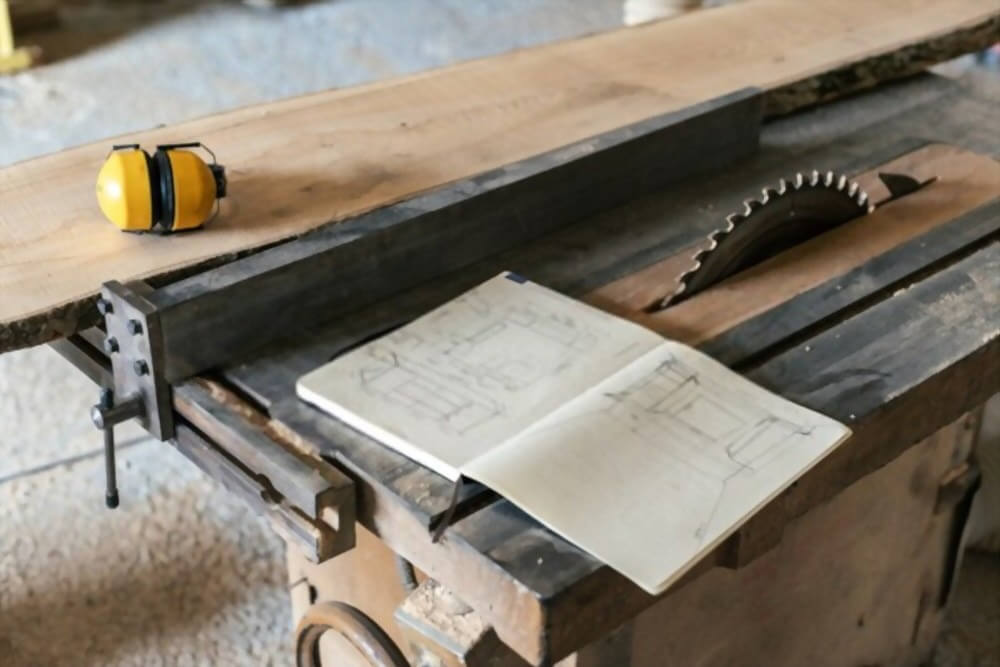Are you a woodworking enthusiast looking to take your craft to the next level? Building a small woodworking shop can provide you with the perfect space to hone your skills and bring your creative ideas to life.
Whether you are just starting out or have years of experience under your belt, having a dedicated space for woodworking is essential. In this article, we will explore the importance of having a small woodworking shop and guide you through the process of creating your own functional and efficient workspace.
Having a dedicated woodworking shop offers numerous benefits for any woodworking enthusiast. Firstly, it provides you with a designated area solely focused on your craft, free from distractions and interruptions. This allows you to fully immerse yourself in the woodworking process and concentrate on producing high-quality pieces. Additionally, a small woodworking shop gives you the freedom to work at any time that suits you without having to pack up tools or worry about making a mess in shared spaces.
Furthermore, a small woodworking shop enables you to organize and store all your tools, materials, and projects in one convenient location. No more searching for missing items or working in cramped conditions. With proper storage solutions and optimized layout design, you can maximize efficiency and productivity in your woodworking endeavors.
In the following sections of this article, we will delve into key considerations for setting up your own small woodworking shop. From assessing available space to planning layouts, choosing essential tools and equipment, creating efficient workstations, organizing storage solutions, ensuring adequate lighting and ventilation, implementing safety measures, and even building on a budget – we’ve got you covered. So let’s get started on transforming that corner of yours into an incredible small woodworking shop where craftsmanship thrives.
Assessing Your Space
When it comes to building a small woodworking shop, one of the first steps is to assess the available space to determine the ideal location and size. Choosing the right location for your shop is crucial for convenience and productivity, while determining the size will ensure that you have enough room to comfortably work on your projects.
Firstly, consider the location of your woodworking shop. Ideally, it should be easily accessible from your home or other areas where you spend a lot of time. This will save you time and effort when moving between your living space and workshop. Additionally, proximity to electrical outlets and plumbing can be important depending on the tools and equipment you plan to use.
Secondly, consider the size of your woodworking shop. The size will depend on factors such as the type of projects you plan to tackle, the tools and equipment you need, and any additional workspace requirements. A general rule of thumb is to allow at least 25 square feet per woodworker in order to have enough room for movement and efficient workflow.
To better visualize your ideal shop layout, create a scale drawing of your available space. This will help you determine how best to arrange your workstations and storage areas based on the dimensions of your tools and equipment. Consider factors such as clearances around machines, accessibility to materials, and adequate floor space for maneuvering larger pieces.
| Location Considerations | Size Recommendations |
|---|---|
| Proximity to home or other frequently visited areas | Allow at least 25 square feet per woodworker |
| Accessibility to electrical outlets and plumbing | Consider the size of tools, equipment, and workspace requirements |
Planning Your Layout
When it comes to planning the layout of your small woodworking shop, optimizing the space for efficiency and safety is crucial. With limited space available, careful consideration must be given to the placement of workstations, tools, and storage areas. Here are some key factors to consider when planning your layout:
Workflow
One of the most important aspects of a well-planned woodworking shop is a logical workflow. You want to arrange your workstations in a way that allows for a smooth progression from one task to another. Start by identifying the main processes involved in your woodworking projects and then arrange your workstations accordingly. For example, you may want to have a designated area for cutting and shaping wood, another area for assembly, and a separate area for sanding and finishing.
Space Optimization
With limited space in a small woodworking shop, it’s essential to make the most out of every square foot. One way to optimize space is by utilizing compact or multi-functional tools whenever possible. Consider investing in combination machines or folding workbenches that can be easily stored away when not in use.
Another strategy is vertical storage solutions. Install wall-mounted shelves or cabinets to store hand tools, clamps, and other smaller items. Utilize pegboards or magnetic strips on the walls to keep frequently used tools within easy reach.
Safety
Safety should always be a priority when planning your woodworking shop layout. Make sure you have clear pathways between workstations so you can move around freely without tripping over cluttered areas. Place heavy machinery such as table saws or planers against sturdy walls or build dedicated stands for them.
Consider installing dust collection systems or using portable dust extractors to minimize airborne dust particles that can pose health risks. Additionally, incorporate proper lighting into your workspace to ensure good visibility while working on intricate tasks.
By carefully planning your layout with workflow optimization and safety in mind, you can make the most out of your small woodworking shop space while still ensuring a productive and safe working environment.
Essential Tools and Equipment
When setting up a small woodworking shop, it is essential to have the right tools and equipment that will enable you to work efficiently and achieve quality results. Here are some must-have items that every woodworking enthusiast should consider including in their small woodworking shop:
- Workbench: A sturdy workbench is the foundation of any woodworking shop. It provides a stable surface for various tasks such as cutting, sanding, and assembly. Look for a workbench that is durable, has ample workspace, and includes features like built-in storage or clamping systems.
- Power Tools: Power tools can significantly speed up your woodworking projects. Some essential power tools include a table saw, miter saw, drill press, thickness planer, and bandsaw. These tools allow you to make precise cuts, shape wood pieces accurately, and create intricate designs.
- Hand Tools: Hand tools are indispensable in any woodworking shop as they provide precision and control when working on smaller projects or fine details. Some important hand tools to have in your collection are chisels, hand planes, mallets, coping saws, and carving knives.
- Safety Equipment: Safety should always be a top priority in any workshop. Invest in safety essentials such as safety glasses or goggles to protect your eyes from flying debris or dust particles. Additionally, wear hearing protection when operating loud machinery and use respiratory masks when working with potentially harmful substances like paint or adhesives.
Including these essential tools and equipment in your small woodworking shop will ensure that you have everything you need to start working on your projects effectively. However, it is important to note that the specific tools you require may vary depending on the types of projects you plan to undertake regularly.
| Must-Have Tool/Equipment | Description |
|---|---|
| Workbench | A sturdy and durable workbench that provides ample workspace and features like storage or clamping systems. |
| Power Tools | Table saw, miter saw, drill press, thickness planer, and bandsaw for making precise cuts and shapes. |
| Hand Tools | Chisels, hand planes, mallets, coping saws, and carving knives for smaller projects or fine details. |
| Safety Equipment | Safety glasses or goggles, hearing protection, and respiratory masks for eye protection, noise reduction, and respiratory safety. |
Setting Up Workstations
When setting up your small woodworking shop, it is important to plan and design efficient work areas for different woodworking tasks. This will not only help you maximize productivity but also ensure safety and organization in your workspace. Here are some tips for setting up workstations in your small woodworking shop:
- Assembly Station: Set up a dedicated area in your shop where you can assemble your wood projects. This workstation should have a large, sturdy workbench where you can lay out and dry-fit pieces before final assembly. Consider installing bench dogs or clamps on the surface to secure your workpieces in place. Keep essential assembly tools such as clamps, hammers, and glue within easy reach.
- Cutting Station: A cutting station is crucial for any woodworking shop. Ideally, this workstation should be equipped with a reliable table saw, miter saw, or circular saw depending on the space available. Make sure to provide enough room for maneuvering long pieces of wood and consider adding support systems like roller stands or sawhorses to assist with handling larger materials.
- Sanding Station: Sanding is an essential step in finishing any woodworking project, so having a dedicated sanding station is important. Set up a sturdy workbench with sanders such as oscillating spindle sanders or belt/disc sanders that cater to the sizes of the projects you typically work on. Be sure to have proper dust collection systems in place to minimize airborne particles from sanding.
To optimize your shop’s space and workflow even further, consider implementing a system of mobile or adjustable workstations that can be easily moved when needed. This allows for flexibility and adaptability based on the size and complexity of each project.
By carefully planning and designing efficient work areas for different woodworking tasks in your small shop, you can improve overall productivity while ensuring safety and organization throughout the space.
Storage and Organization
Storage and organization are key aspects of any small woodworking shop. By effectively maximizing space and keeping your shop tidy, you can enhance efficiency and productivity while also maintaining a safe working environment. In this section, we will explore some creative solutions for storage and organization in a small woodworking shop.
Utilize Vertical Space
One of the most effective ways to maximize storage in a small woodworking shop is by utilizing vertical space. Consider installing wall-mounted shelves or cabinets to keep your tools and supplies off the floor and within easy reach. Look for innovative storage solutions such as pegboards, magnetic strips, or tool racks that can be mounted on the walls. These allow you to hang smaller hand tools, clamps, or other items without taking up valuable floor or countertop space.
Invest in Storage Systems
To keep your small woodworking shop organized, invest in storage systems that are specifically designed for woodworkers. Modular storage units with adjustable shelves and drawers can provide a customizable solution to fit your needs. Additionally, consider purchasing stackable storage bins or clear plastic containers to store smaller items like screws, nails, or sandpaper. Label each bin or container so that you can easily find what you need when working on a project.
Create Dedicated Stations
Designating specific workstations for different woodworking tasks can help streamline your workflow and keep your shop organized. Set up separate areas for cutting, sanding, assembly, and finishing. Each station should have its own designated tools and equipment so that everything is within arm’s reach when needed. Consider using mobile carts or workbenches with built-in storage compartments to make it easier to transport materials and tools between stations.
Maintain a Clean Work Area
Keeping your small woodworking shop tidy is essential not only for efficiency but also for safety purposes. Regularly sweep the floors to remove wood chips, dust, and debris that can pose a tripping hazard or become airborne. Have a designated waste bin or container for disposing of larger scrap pieces, and empty it frequently to prevent clutter from accumulating. Develop a habit of cleaning up after each woodworking session to maintain an organized work area.
By incorporating these creative storage and organization solutions in your small woodworking shop, you can significantly maximize space and ensure that everything is easily accessible. A tidy and well-organized shop will not only enhance efficiency but also contribute to a safer working environment. So take the time to assess your storage needs, invest in appropriate storage systems, create dedicated workstations, and maintain cleanliness – your small woodworking shop will be fully optimized for productivity and success.
Lighting and Ventilation
Lighting and ventilation are crucial elements to consider when setting up a small woodworking shop. Proper lighting is essential for visibility, allowing you to accurately measure and work with precision. Adequate ventilation, on the other hand, helps maintain a healthy and safe environment by removing dust, fumes, and potentially harmful airborne particles.
When it comes to lighting your small woodworking shop, natural light is always the best option. If possible, set up your shop in an area that has access to plenty of windows or skylights. Natural light not only provides better visibility but also creates a more pleasant working environment.
However, it is important to supplement natural light with artificial lighting as well. Install overhead lights or task lights at strategic locations throughout your shop to ensure that every corner is well-lit.
Ventilation is another vital aspect of a small woodworking shop. Woodworking processes often generate dust, fumes, and other airborne particles that can pose health risks if inhaled over time. To combat this issue and maintain good air quality, invest in a good quality dust collection system or an air filtration system. A dust collection system will help remove larger wood particles and sawdust efficiently while an air filtration system will capture smaller airborne particles.
Additionally, make sure there is proper airflow in your shop by installing fans or opening windows whenever possible. This will help prevent stagnant air from accumulating in the space. It’s also important to keep your workspace clean and free from clutter as this can impede proper airflow.
Safety Measures
Implementing safety measures and using proper safety equipment is crucial to protect yourself and others in your small woodworking shop. Woodworking involves various tools and machinery that can pose serious risks if not used correctly. By following best practices and taking necessary precautions, you can create a safe environment for yourself and anyone else working in your shop.
One of the fundamental safety measures is wearing appropriate personal protective equipment (PPE). This includes safety glasses or goggles to protect your eyes from flying debris, earplugs or earmuffs to reduce noise exposure, and a dust mask or respirator to prevent inhaling sawdust particles. It is also important to wear sturdy footwear with non-slip soles to prevent slipping accidents.
In addition to wearing PPE, it is essential to maintain a clutter-free workspace. Keep walkways clear of obstructions and ensure that tools and materials are properly stored when not in use. This reduces the risk of tripping hazards and prevents accidents caused by falling objects.
Furthermore, familiarize yourself with the specific safety protocols for each tool or machine you use in your woodworking shop. Always read the user manuals, follow instructions carefully, and seek training if needed. Understanding how each tool works and its associated risks will help you avoid accidents caused by misuse or improper handling.
Lastly, fire prevention should be a key concern in any woodworking shop. Ensure that your shop is equipped with proper fire extinguishers, smoke detectors, and fire alarms. Keep flammable materials stored safely away from potential ignition sources, such as sparks or heat-producing equipment.
By implementing these safety measures and having the right safety equipment in place, you can greatly reduce the risk of accidents or injuries in your small woodworking shop. Remember to regularly inspect your tools for any signs of damage or wear, as well as educate yourself on any new safety guidelines or regulations that may be relevant to woodworking practices.
With a focus on safety, you can create a secure environment where you and others can enjoy the art of woodworking without unnecessary risks.
Budget-Friendly Tips
Building a small woodworking shop doesn’t have to break the bank. With some budget-friendly tips and strategies, you can create a functional and efficient woodworking space without spending a fortune.
One of the first things to consider when building a small woodworking shop on a limited budget is to prioritize your purchases. Identify the essential tools and equipment that you absolutely need to get started, such as a workbench, table saw, miter saw, and drill press. Focus on acquiring these key items first before moving on to other tools that may be nice to have but are not immediately necessary.
Another cost-saving tip is to consider buying used or refurbished tools. Many times, you can find high-quality woodworking tools at significantly discounted prices through online marketplaces or local classified ads. Just make sure to thoroughly research any used tools before making a purchase to ensure they are in good working condition.
Additionally, repurposing or upcycling materials can help save money when building your small woodworking shop. Look for opportunities to use reclaimed wood or repurpose furniture items for storage instead of buying brand new materials. You can also get creative with storage solutions by using inexpensive bins, shelves, and hooks from discount stores.
Lastly, consider enlisting the help of friends or fellow woodworking enthusiasts who may be willing to lend or share tools and equipment. This can help cut down on costs as you start building your shop and allow you access to a wider range of tools without having to invest in everything upfront.
Remember, building a small woodworking shop on a limited budget requires careful planning and resourcefulness. By prioritizing your purchases, considering used tools, repurposing materials, and seeking assistance from others, you can create an affordable yet fully functional space where you can pursue your woodworking passion.
Conclusion
In conclusion, building a small woodworking shop is essential for any woodworking enthusiast. It provides a dedicated space where you can unleash your creativity and work on your projects with efficiency and safety.
Throughout this article, we have covered various aspects of setting up a small woodworking shop, from assessing your space to planning the layout, acquiring essential tools and equipment, setting up workstations, organizing storage, ensuring proper lighting and ventilation, implementing safety measures, and doing it all within a limited budget.
By determining the ideal location and size of your small woodworking shop, you can ensure that it fits your needs and allows for comfortable movement while working. Planning the layout will optimize the use of space and create efficient work areas for different woodworking tasks. Investing in essential tools and equipment is crucial to ensure that you have everything you need to carry out your projects successfully.
Setting up workstations tailored to specific tasks will enhance productivity, while creative storage solutions will maximize space utilization and keep your shop tidy. Proper lighting and ventilation are vital for visibility and airflow, promoting both productivity and safety. Implementing safety measures such as best practices and safety equipment is crucial to protect yourself and others in the shop.
Furthermore, building a small woodworking shop doesn’t have to break the bank. With budget-friendly tips in mind, you can create an amazing workspace without overspending. Ultimately, starting your small woodworking shop today will not only allow you to pursue your passion but also provide a place where you can immerse yourself in the craft while enjoying comfort, efficiency, organization, safety, and creativity.
So what are you waiting for? Take the knowledge from this article, put it into action, gather the necessary materials and start building your dream small woodworking shop today. Embrace the joy of working with wood in a dedicated space that reflects your personality and style. Happy woodworking.
Frequently Asked Questions
How do you layout a small woodshop?
When laying out a small woodshop, it is important to first assess the available space and consider the flow and functionality of the workshop. Begin by designating zones for different woodworking activities such as cutting, sanding, and assembly. Consider arranging your tools and workstations in a logical order that allows for efficient movement between tasks. Maximize vertical space by hanging tools on walls or using wall-mounted storage systems.
Utilize sturdy workbenches or mounted tables with adequate workspace. Pay attention to lighting, ventilation, and safety measures such as installing fire extinguishers and implementing good dust collection systems. By organizing your small woodshop thoughtfully, you can optimize productivity and create an environment conducive to creativity.
How to build a wood work shop?
Building a wood workshop requires careful planning and consideration of important factors. Start by determining the size of the workshop based on available space and your woodworking needs. Create a solid foundation for your workshop that can support heavy machinery and provide stability for your projects. Construct sturdy walls using materials appropriate for insulation and soundproofing if necessary.
Install reliable electrical outlets throughout the workshop at convenient locations for powering equipment. Consider incorporating large windows or skylights to maximize natural light and ventilation. Lastly, set up ample storage solutions to keep your tools organized, easily accessible, and safe from damage.
How do I set up a small wood workshop for under $1000?
Setting up a small wood workshop on a budget of under $1000 may require some strategic choices but is certainly achievable with careful planning. Start by prioritizing essential tools such as a table saw, miter saw, or circular saw which can be found secondhand or as part of bundle deals to save money. Identify local auctions, garage sales, or online platforms where used tools are available at affordable prices while ensuring they are in good working condition before purchasing them.
To save further costs on lumber storage solutions, consider utilizing inexpensive shelving units made from cinder blocks and wooden planks instead of buying pre-built tool cabinets or racks. Additionally, explore DIY options for workbenches to avoid expensive store-bought alternatives. Remember, a budget-friendly wood workshop can still be functional and efficient by making smart choices and focusing on essential tools and equipment.

Hi everyone! I’m a woodworker and blogger, and this is my woodworking blog. In my blog, I share tips and tricks for woodworkers of all skill levels, as well as project ideas that you can try yourself.





